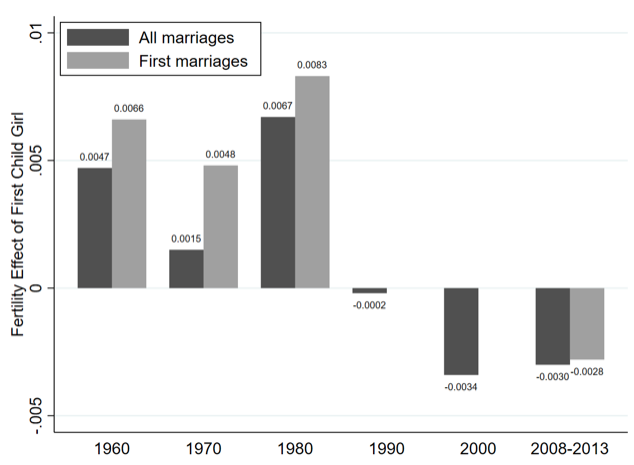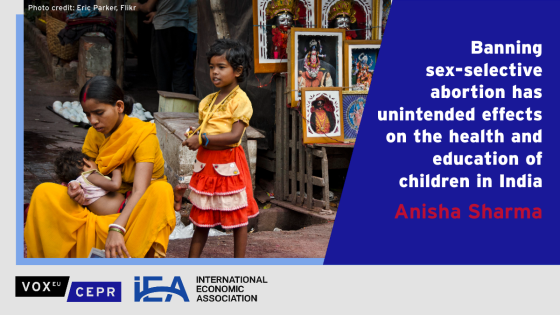Economists have long been interested in the unequal treatment of women and men within families, since such inequities both reflect and contribute to broader societal gender differences. The inequities may manifest early in the life cycle as a ‘son preference’ when a child’s gender impacts family structure and future fertility, sex-selective abortions are performed, sex differences alter parental time inputs, or access to health care and nutrition is affected (e.g. Dahl and Moretti 2008, Anderson and Ray 2010, Almond and Edlund 2008, Abrevaya 2009, Almond et al. 2013, Lundberg 2005).
Some of the strongest evidence of son preference comes from developing countries. Sen (1990), for example, inferred that the millions of ‘missing women’ in China and India had resulted largely from neglect in health care and nutrition. More recently, sex-selective abortion has come to play a role in unbalanced gender ratios, with (male/female) sex ratios at birth rising in a number of countries, most of them in Asia (Bongaarts 2013). However, studies by sociologists, psychologists, and more recently by economists, have also found evidence of different behaviour in the parents of sons and daughters in developed countries. In a comprehensive review, Lundberg (2005) points to two fairly robust findings: sons increase family stability and, overall, fathers tend to spend more time with sons than with daughters. While such differences may be identified, it is unclear whether they reflect son preference or constraints, such as differences in the productivity of fathers and mothers in parenting sons versus daughters, or differences in costs of boys versus girls (Lundberg 2005).
Some past evidence is consistent with son preference in the US
In a landmark study for the US, Dahl and Moretti (2008) found evidence consistent with son preference. Crucially, they found that not only did a female first child increase the probability of living without a father; it also raised a couple’s subsequent fertility. This combination of results helps to rule out alternative explanations to son preference for their family-structure findings.
One alternative explanation for the family-structure finding is that raising girls is more expensive than raising boys, making fathers more reluctant to shoulder this burden (e.g. Lundberg 2005, Dahl and Moretti 2008). This possibility is especially plausible in more recent decades: beginning in the 1980s, girls had a greater propensity to attend college than did boys (Goldin et al. 2006). But if having a daughter is more costly, that factor should lower fertility, not raise it. Another possibility is that parents believe the lack of a male role model is more harmful for boys than girls, or that fathers have a comparative advantage in raising sons (Lundberg 2005, Dahl and Moretti 2008).
Both ideas are consistent with recent empirical evidence suggesting that the negative effects of growing up economically disadvantaged, particularly in a single-mother family, are more harmful for boys than for girls (Autor et al. 2019, Bertrand and Pan 2013). However, if fathers have a comparative advantage in raising boys, this would also make girls more expensive to raise, assuming the advantage is not offset by differences in maternal productivity in raising girls versus boys. This expense would also lower the probability of having additional children. Thus, Dahl and Moretti’s fertility findings are crucial to the conclusion that son preference exists in the US. But the evidence on fertility in the US and other developed countries is somewhat mixed, with several studies finding evidence of a negative effect that girls have on fertility for some countries, including the US (Abrevaya 2009, Ichino et al. 2014, Andersson et al. 2011).
New evidence: Son preference appears to have declined in the US
The mixed findings on son preference and fertility in developed countries motivated us to revisit the question of son preference in the US in light of more recent data (Blau et al. forthcoming). Updating is important because Dahl and Morreti’s (2008) analysis of family structure used data from 1960-2000 and, more significantly, their results for fertility used data from 1960-1980. Further, in light of the increase in immigration and the research showing that recent immigrant waves tend to come from countries with a more traditionally gendered division of labour than the US (Blau at al. 2011), immigrants and natives should be analysed separately. To examine these questions, we use 2008-2013 American Community Survey (ACS) data supplemented by data from the 1995-2014 Current Population Surveys.
Among the population in the aggregate, as well as among the native-born separately, we find that having a female first child continues to increase the likelihood of living without a father. In contrast to Dahl and Moretti’s (2008) earlier findings, however, we find that for the overall population, as well as among natives separately, having a female first child is now associated with lower fertility, and significantly so for natives. These changing results are shown in Figure 1, which depicts the impact a female first child has on future fertility over time for all married couples and for those in their first marriages (when data are available). It uses data from Dahl and Moretti (2008) for 1960-2000 and data from Blau et al. (forthcoming) for 2008-2013, while keeping the same regression specification for each year and including control variables for age, education, race/ethnicity, birth cohort, and region. The figure shows a positive effect of girls through 1980, an impact consistent with son preference. However, the effect falls to roughly zero in 1990 and turns negative after that. Thus, after 1990, there now appears to be a negative effect of a female first child on fertility.
Figure 1 Effect of a female first child on fertility by year
Notes: Estimates for 1960-2000 are calculated using Dahl and Moretti (2008) data, available at https://econweb.ucsd.edu/~gdahl/sons-code.html. Estimates for 2008-2013 are calculated using the American Community Survey (used in Blau et al. forthcoming) with the Dahl and Moretti (2008) specification and sample restrictions. Information on first marriages is not available for 1990 and 2000. Control variables include age, education, race/ethnicity, birth cohort, and region.
Do parents in the aggregate, and natives in particular, now prefer daughters? This might be the case, but there are alternative explanations for our findings other than daughter preference. One contributing factor could be a rise in the costs of raising girls due to educational expenditures, given the trends in female education noted above. Kornrich and Furstenberg (2013) provide some direct evidence on rising relative costs of raising girls and boys, with girls being associated with lower expenditures in 1972-3 but higher expenditures by 2006-7, largely due to educational expenses. The spending data could also reflect a reduction in son preference, since they indicate that families are now willing to spend more on girls, particularly their education.
The increased expenditure on girls and the less generative effect of girls on fertility could also reflect an increase in the bargaining power of wives. Some data suggest aggregate preferences for the sex of a child have not changed over time and that son preference appears to be a male phenomenon – that is, while men have a preference for boys over girls, women show no preference either way (Newport 2011). Thus, the disappearance of a positive effect of a female first child on fertility – in the aggregate and for natives – could indicate that women have a greater say in this decision than previously. An increase in female bargaining power is plausible in light of rising female labour-force participation and relative wages (Blau and Kahn 2017).
Our findings imply either a reduction among natives in the preference for boys and/or an increase in the impact of these other factors sufficient to outweigh the preference for boys. The possible impact of these various factors makes us reluctant to interpret our finding of a first female child’s negative effect on native fertility as indicating a shift from son to daughter preference, although of course it might. What is clear is that our results remove a crucial piece of supporting evidence for the argument that the positive effect of a first girl on the probability of living without a father is due to son preference as opposed to other factors.
Considering immigrants separately, we find some evidence that having a female first child contributes to the incidence of living without a father, although the impact is statistically insignificant. In contrast to our findings for natives, we find a positive effect of a female first child on fertility, suggesting the influence of a son preference in fertility among immigrants. This interpretation is further supported by evidence that, for both first- and second-generation immigrants (i.e. immigrants and their native-born children), having a girl has a more positive effect on fertility for those from countries with less gender equality, as measured by the World Economic Forum’s (WEF) Global Gender Gap Index and other indicators. In contrast, we found little evidence that the impact of having a girl on living without a father was stronger among first- and second-generation immigrants from countries with lower gender equality. Thus, in contrast to the fertility results, we do not show that the relationship between a female first child and living without a father is tied to a son preference for immigrants or the second generation.
We also examined another indicator of son preference, sex selection, by estimating the impact of the sex composition of previous children on the probability that a given birth is a boy. We found no evidence that sex selection characterizes the aggregate native and immigrant populations, although previous work indicates it occurs for some groups (e.g. Almond and Edlund 2008, Abrevaya 2009). This suggests that an increase in sex selection among the native-born, as an alternative manifestation of son preference, is not driving our fertility findings.
References
Abrevaya, J (2009), “Are There Missing Girls in the United States? Evidence from Birth Data”, American Economic Journal: Applied Economics 1(2): 1-34.
Almond, D and L Edlund (2008), “Son-Biased Sex Ratios in the 2000 United States Census”, Proceedings of the National Academy of Sciences 105(15): 5681-5682.
Almond, D, L Edlund and K Milligan (2013), “Son Preference and the Persistence of Culture: Evidence from South and East Asian Immigrants to Canada”, Population and Development Review 39(1): 75-95.
Anderson, S and D Ray (2010), “Missing Women: Age and Disease”, Review of Economic Studies 77(4): 1262-1300.
Andersson, G, K Hank, M Rønson and A Vikat (2006), “Gendering Family Composition: Sex Preferences for Children and Childbearing Behavior in the Nordic Countries”, Demography 43(2): 255-267
Autor, D, D Figlio, K Karbownik, J Roth and M Wasserman (2019), “Family Disadvantage and the Gender Gap in Behavioral and Educational Outcomes”, American Economic Journal: Applied Economics 11(3): 338-381.
Bertrand, M and J Pan (2013), “The Trouble with Boys: Social Influences and the Gender Gap in Disruptive Behavior”, American Economic Journal: Applied Economics 5(1): 32-64.
Blau, F D and L M Kahn (2017), “The Gender Wage Gap: Extent, Trends, and Explanations”, Journal of Economic Literature 55(3): 789-865.
Blau, F D, L M Kahn, P Brummund, J Cook and M Larson-Koester (Forthcoming), “Is There Still Son Preference in the United States?”, Journal of Population Economics.
Blau, F D, L M Kahn and K L Papps (2011), “Gender, Source Country Characteristics, and Labor Market Assimilation Among Immigrants”, Review of Economics and Statistics 93(1): 43-58.
Bongaarts, J (2013), “The Implementation of Preferences for Male Offspring”, Population and Development Review 39(2): 185–208.
Dahl, G B and E Moretti (2008), “The Demand for Sons”, Review of Economic Studies 75(4): 1085-1120.
Goldin, C, L F Katz and I Kuziemko (2006), “The Homecoming of American College Women: The Reversal of the College Gender Gap”, Journal of Economic Perspectives 20(4): 133-156.
Ichino, A, E-A Lindström, and E Viviano (2014), “Hidden Consequences of a First-born Boy for Mothers", Economics Letters 123: 274-278.
Kornrich, S and F Furstenberg (2013), “Investing in Children: Changes in Parental Spending on Children, 1972-2007”, Demography 50(1): 1-23.
Lundberg, S (2005), “Sons, Daughters, and Parental Behavior”, Oxford Review of Economic Policy 21(3): 340-356.
Newport, F (2011), “Americans Prefer Boys to Girls, Just as They Did in 1941”, Gallup, 23 June.
Sen, A (1990), “More Than 100 Million Women are Missing”, The New York Review of Books 37(20).









